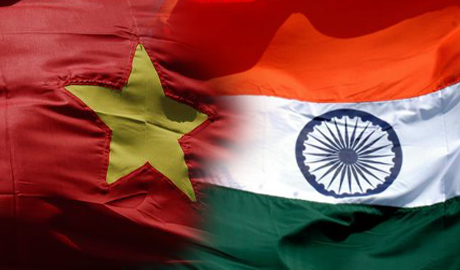New Delhi- Vietnam has renewed India's lease of two oil blocks in the South China Sea for another year, on the eve of Indian foreign minister Sushma Swaraj's first visit to Hanoi next week, state run PTI reported today. The move reaffirms India's position as a continuing commercial stakeholder in a region where territorial disputes between Southeast Asian nations and China have flared up recently.
Swaraj will travel up to China for a meeting of the almost irrelevant Russia-India-China grouping, before having bilateral meetings with her Chinese counterpart, Wang Yi. The meeting is part of the preparation for Chinese premier Xi Jinping's visit in mid September.
The oil blocks, 128, have little commercial value because the Indian entity, OVL had concluded there is little prospect of striking oil in that area. After India gave up the blocks in 2012, Vietnam persuaded India to stay on to explore further. That lease expired this year and has just been renewed. India clearly remains there because it believes it has strategic interests in the South China Sea. India maintains the importance of free lanes of navigation and access to resources. It also gives India a very good reason to keep a naval presence there. Indian naval vessels run goodwill visits in all the countries affected by China's expansionist foreign policy.
Chinese assertiveness in South China Sea sharpened in May this year, when China sent its mobile oil rig Haiyang Shiyou 981 to Vietnamese waters for alleged oil exploration, despite Hanoi's protests. Although the Chinese withdrew on July 15, it stamped its hegemonic presence there, asserting its right to move at will. More recently, China has announced it will build lighthouses on five islands in South China Sea, of which two islands are in waters claimed by Vietnam. This was announced as a reaction to a possible move by Association of Southeast Asian Nations (ASEAN) countries to freeze all activity. China showed it would build whatever, wherever on the East Sea. According to Beijing's maps, China claims almost 90 per cent of the East Sea.
The Chinese strategy in South China Sea is the same as it is in Depsang and Demchok area in Ladakh. It makes a series of small transgressions, each individually not big enough to spark a conflict. But repeating the same exercise, China seeks to change the status quo in its favor. Recently, China had also dispatched a minor flotilla of fishing vessels around Phillippines, to assert its claims.
Vietnam is building ties with others and has drawn closer to US, Japan Korea and India. Japanese foreign minister Fumio Kishida recently announced Japan would give six used naval boats to Vietnam to boost its patrols and surveillance capacity in the East Sea. Vietnam also wants India's Brahmos missile but the UPA government has dragged its feet on the decision, largely because of the dangers of the missile designs ending up with the Chinese.
Sunday, November 24, 2024
Vietnam renews lease of Indian oil blocks in South China Sea

Caption: Vietnam renews lease of Indian oil blocks in South China Sea
10:19 AM | November 23, 2024
Govt decides to provide special facilities to Chinese companies in SEZs
November 24, 2024
Textile exports up by 10.44pc to $6.14b in four months
November 24, 2024
Foods exports surge by 21.73pc to $2.36 billion in July-October
November 24, 2024
ICCI, FTO host awareness session on taxpayers’ rights
November 24, 2024
Customs foils mega smuggling attempt at Lahore Airport
November 24, 2024
-
Digital nomadism redefines work and travel across the globe
-
Digital nomadism redefines work and travel across the globe
-
Lahore tops global pollution rankings as smog worsens, AQI reaches hazardous levels
-
Hunger crisis to increase in South Sudan, warns UN
-
Pakistan’s judiciary champions climate justice at COP29 in Baku
-
Punjab struggles with persistent smog as Met Office forecast rainfall
Paper Justice
November 23, 2024
No Silver Bullet
November 23, 2024
Reckless Accusations
November 23, 2024
UN Crossroads
November 22, 2024
Smog Trade-off
November 22, 2024
The World: No Longer Livable
November 23, 2024
Unveiling Protein Secrets with AI
November 23, 2024
Outdated Policy
November 23, 2024
Brain Drain
November 23, 2024
Proposal to counter increasing cases of harassment
November 22, 2024
ePaper - Nawaiwaqt
Nawaiwaqt Group | Copyright © 2024





